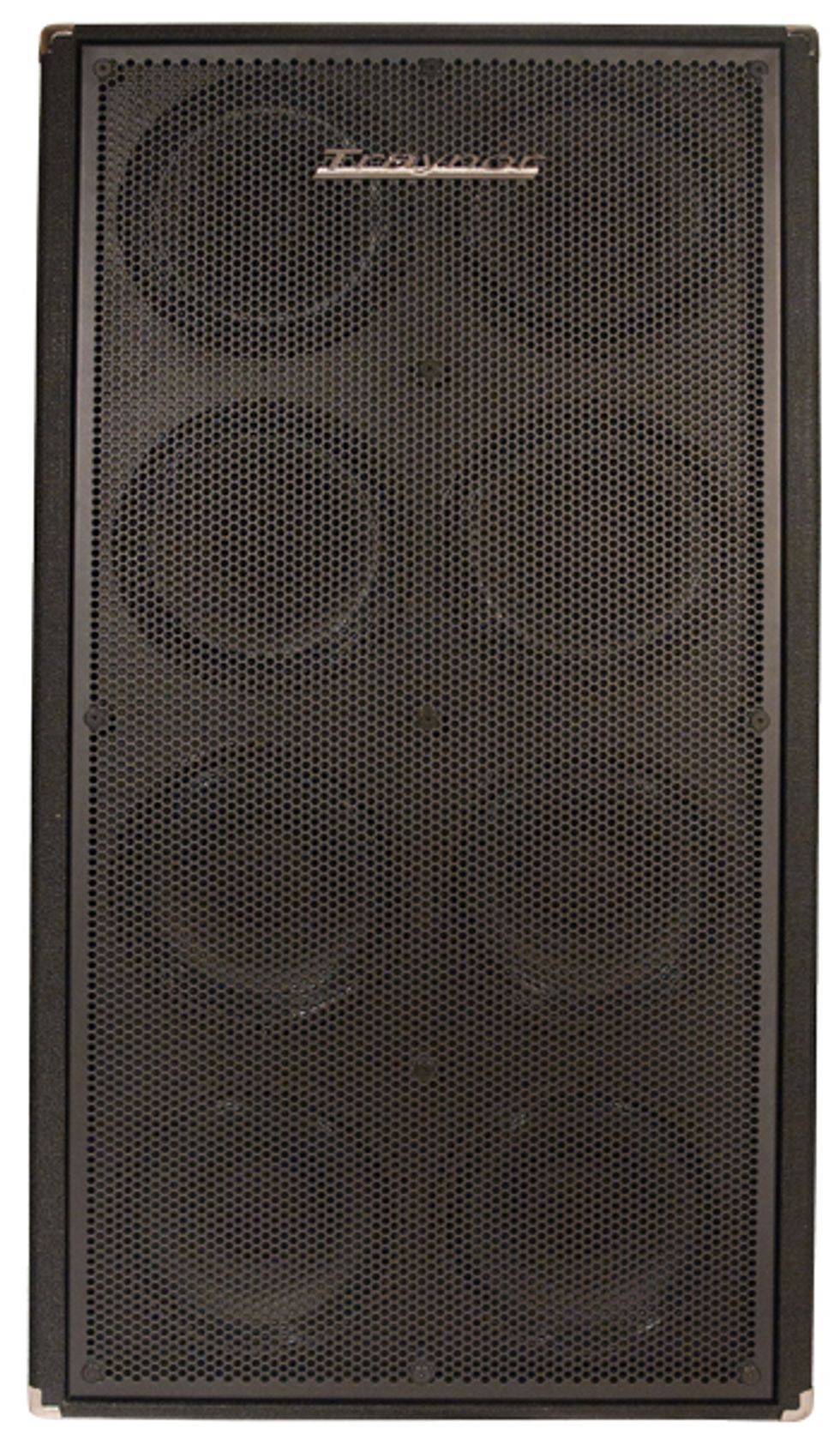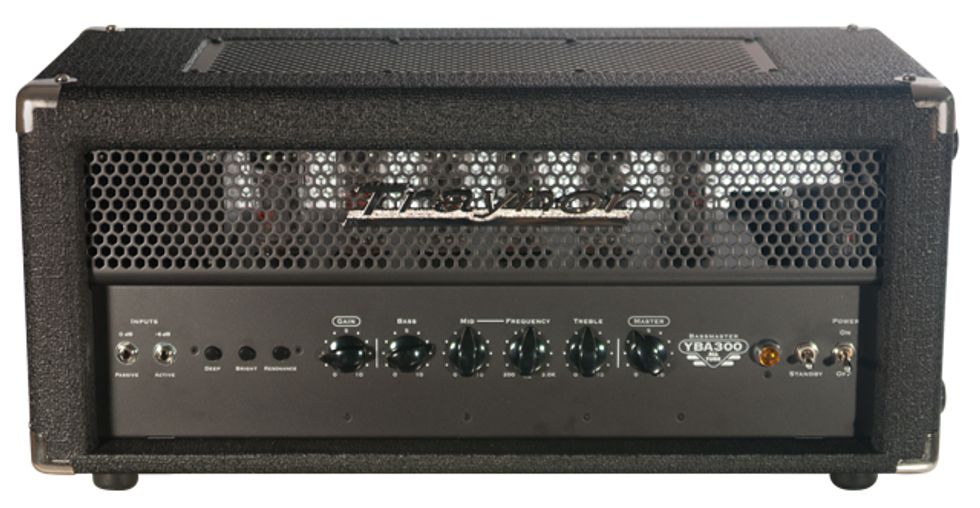
Since producing the first portable PA speaker columns back in 1963, Traynor has made major strides in the world of amplification. Traynor amps are prized by their fans for their heady, punchy cleans and ample volume. It has also been a company keen on helping bassists in their quest for tone, having designed and manufactured one of the world’s first 8x10 bass cabinets decades ago. The new YBA300 bass amplifier— which packs 300 watts of all-tube power—continues to drive Traynor’s reputation for big tone and high headroom, with plenty of tone to spare.
Welcome to the Thunderdome
Bassists who swoon at the sight and sound
of late-’60s to early-’70s vintage Ampeg
SVT rigs should feel right at home with
Traynor’s pummeling powerhouse. The
amp was designed with those massive,
rumbling tones in mind and coupled with
considerations for modern reliability.
The YBA300’s circuit is entirely tube based, which is sadly a rarity in the world of modern bass amps. Three 12AX7s process the preamp signal, along with a 12AU7 acting as a driver between the preamp and power amp. Speaking of the power amp, the YBA300’s absolutely ridiculous amount of volume is fueled by 12 power-amp tubes, which can easily be switched between 6L6’s and EL34’s via a panel on the back of the amp. With a maximum wattage of 300 watts, the YBA300 is sure to satisfy any bassist’s cravings for more power, punch, and expansive volume. Each pair of power-amp tubes has its own dedicated bias adjustment control, along with LED indicators to indicate if the bias is too high or too low. If the dreadful case occurs where one, or an entire pair goes bad during a gig, the circuit is designed to knock out the offending tubes safely, keeping the amp running steadily for the time it takes to finish the set and get them replaced.
The majority of the amp’s tone is shaped from four EQ controls, as well as separate Gain and Master volume knobs to adjust the volume and overall sharpness and softness of the sound. A standard grouping of Bass, Mid, and Treble controls are laid out in a familiar fashion, along with Mid Frequency knobs for sweeping through the 200 Hz-3.0 kHz mid-range frequencies. Directly to the left of the controls are three tone-shaping, push buttons— Deep, Bright, and Resonance— which add varying degrees of extra subs, brighter cut, and even more low-end muscle to the already walloping tone. Separate jacks for basses with active or passive pickups are onboard as well.
Bringing a separate DI box—or even worse, hoping that the sound guy at the gig knows his stuff and has an extra one on hand—isn’t a concern with the YBA300, since it has its own built-in XLR DI/Line Out jack on the back panel. The DI can also be can be switched to either pre or post configurations. Rounding out the features is a serial effects loop, just in case you want to throw in your favorite parametric EQ or other effects.
She’s Got Balls
As I mentioned previously, the YBA300
yearns to please those who desire deep, rich
bass with an immense amount of volume
and heft behind it. This amp was made to
fill large venues and make sure the crowd in
back at an outdoor gig can hear you loud
and clear.
To help the YBA300 accomplish its mission, Traynor designed the TC810. A mammoth 8x10 cabinet made with solid, birch plywood slabs and covered in thick Nubex material, the TC810 boasts a metal grille and handles, skid rails, and built-in wheels to tilt the cab back for easy transport. Moving the 1600-watt cabinet—which can also be split into separate 800-watt, 4x10 configurations—was a real back breaker due to the density of the birch ply construction. Birch plywood is considerably heavier than the commonly-used particleboard or medium- density fiberboard, but Traynor claims this helps the tone project with stronger authority and body. I was in complete agreement after plugging in a 2011 Gibson Les Paul Jr. DC bass and laying down some stoic, rock grooves.
The tone of the YBA300 was staggeringly huge. As I worked with some Clutch-inspired, bluesy, hard rock lines, I didn’t have a need to move the Bass control higher than 1 o’clock. The tone breathed naturally as I alternated varying degrees of finger picking attack, heaving in and out like a strong wave of water hitting my chest with every note, I plucked on the Gibson’s short-scale neck. All the EQ controls had a good amount of range, but the Mid Frequency control seemed to make a noticeable difference only when I moved into the 2.0 kHz range.
One of the best things about an alltube preamp is that the Gain control can be used for tailoring the feel and response of the tone, rather than just piling on distortion. The YBA300 exemplified this well as I moved the Gain control to the upper registers of 2 o’clock and beyond, which softened the highs, thickened the mid-range, and pushed the low end to even deeper territory. There wasn’t a lot of onboard overdrive available from the amp—just enough to add a slight amount of grit to the top end—but the YBA300 doesn’t appear to be designed for the heavy overdrive crowd. Instead, Traynor gives a nod to the old-school style of using the preamp Gain knob for altering the overarching response and feel of the tone—a refreshing approach in these days of modern, saturation-soaked amplification.
Even with all the glee I was experiencing while exploring the amp’s tonal offerings, the real fun began when I started kicking in the Deep, Bright, and Resonance switches. The Deep switch added extra subs and a slight amount of extra cut on the treble, making it perfect for modern, hard-rock bass tones that demand a solid foundation underneath heavy guitar-riffing. While the Bright switch performed its designated job well—simply boosting the treble a tiny amount—the real kicker came from engaging the Resonance control. This effectively removed a large portion of dampening on the low frequencies and allowed the bass to bloom and vibrate in exhilarating ways. Even with the Master Volume at 10 o’clock, this was not for the faint of heart. Two pieces of glassware, located two rooms away, vibrated off a shelf and shattered with the Resonance control engaged. The tonal experience was not just hearing with my ears and feeling with my hands, but vibrations through my entire body—all without any excessive abrasiveness in the highs or low mid-range.
The Verdict
Traynor’s YBA300 head is a must-play for
any bassist who’s serious about big volume
and tone. It’s a rock bassist’s dream, if that
dream involves massive, all-encompassing
tones that sustain and bloom naturally
with a good playing style. It’s certainly
capable for a myriad of other musical
styles with its highly responsive EQ section,
but just like any other good tube
amp, it sounds best when pushed. That
said, it’s also the YBA300’s only real downfall.
The amount of volume thrown out
when it’s really cooking could be too much
for a number of players—and a good way
to piss off the sound guy if you’re not careful
with the controls! But if you yearn for
more power and a desire for your tone to
punch you right in the lunch, there aren’t
many other choices that I can recommend
highly enough.
Watch the video review:
Buy if...
big, boisterous bass with incredible definition and expansiveness are what’s needed to take your music to the next level.
Skip if...
you need to lay back in the mix with a less-aggressive presence.
Rating...
Street $1388 - Traynor - traynoramps.com |
TC810
Buy if...
you need pant-leg-flapping power to push your bass tone with commanding authority, along with copious amounts of clarity.
Skip if...
your back can’t handle hauling a bulky, 157 pound cab back and forth to gigs.
Rating...
Street $1079 - Traynor - traynoramps.com |








![Rig Rundown: AFI [2025]](https://www.premierguitar.com/media-library/youtube.jpg?id=62064741&width=1245&height=700&quality=70&coordinates=0%2C0%2C0%2C0)












 Shop Scott's Rig
Shop Scott's Rig
![Rig Rundown: Russian Circles’ Mike Sullivan [2025]](https://www.premierguitar.com/media-library/youtube.jpg?id=62303631&width=1245&height=700&quality=70&coordinates=0%2C0%2C0%2C0)














































